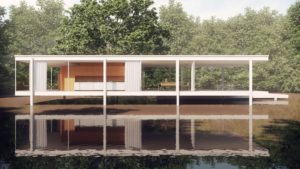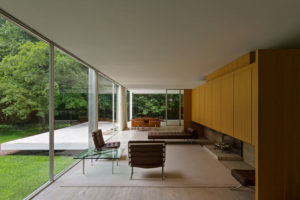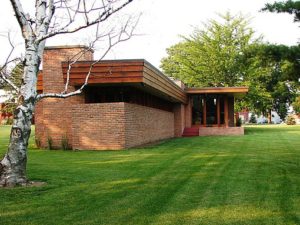 After Fallingwater, Mies van der Rohe’s Farnsworth House, built in 1951, is probably the best-known modern house in America, if not the world. At first glance the two buildings appear to have nothing in common save their self-evident modernity. Yet Mies’ half-visible glass house and Frank Lloyd Wright’s massive cantilevered concrete slabs turn out to be not altogether dissimilar in both purpose and effect.
After Fallingwater, Mies van der Rohe’s Farnsworth House, built in 1951, is probably the best-known modern house in America, if not the world. At first glance the two buildings appear to have nothing in common save their self-evident modernity. Yet Mies’ half-visible glass house and Frank Lloyd Wright’s massive cantilevered concrete slabs turn out to be not altogether dissimilar in both purpose and effect.
I visited Fallingwater for the first time in 2003 and later blogged about the experience, trying to imagine what it might feel like to live there. I was impressed but skeptical:
I think it would be a profoundly soul-satisfying experience to live in Fallingwater–if you were rich enough to afford a staff of servants and young enough to negotiate the stairs….Fallingwater is one of the most extraordinary buildings in the world, fully deserving of its singular reputation. I’ve never seen a more beautiful house in my life. But I wouldn’t be altogether surprised if in the very long run, Wright’s Usonian houses prove to have been a more significant contribution to Western culture.
The Farnsworth House is at least as beautiful as Fallingwater, and in judging its success as a residence, one must keep firmly in mind the specific purpose for which it was built. Edith Farnsworth, a successful Chicago doctor, was a spinster who used the house not as a full-time home but as a weekend retreat. (Fallingwater was also designed for the weekend use of a wealthy family.) This explains the lack of shelf and storage space, as well as Mies’ failure to provide for the presence of non-intimate overnight guests. Dr. Farnsworth went there to commune with nature, and I can’t think of a better place to do so. The glass walls pull your gaze irresistibly outward to the surrounding meadow, and the house itself seems to dissolve into the clearing in which it was built.
 The problem with the Farnsworth House–and with all minimalist architecture–is that it is cruelly unforgiving of the ordinary clutter of everyday life. As one art historian admiringly put it:
The problem with the Farnsworth House–and with all minimalist architecture–is that it is cruelly unforgiving of the ordinary clutter of everyday life. As one art historian admiringly put it:
All of the paraphernalia of traditional living–rooms, walls, doors, interior trim, loose furniture, pictures on walls, even personal possessions–have been virtually abolished in a puritanical vision of simplified, transcendental existence.
I’m an unusually neat person and so could imagine living in the Farnsworth House, but I suspect that most people would find it unbearably oppressive, just as Edith Farnsworth herself came to loathe the lack of privacy that inevitably goes with spending weekends living in a world-famous glass house. She ruefully admitted that it made her uncomfortable to see even as much as a single coathanger out of place. That’s no way to live.
Wright is no less often accused of having emphasized beauty at the expense of comfort, and that accusation carries a certain amount of weight when it comes to Fallingwater. Not so, however, the one-story Usonian ranch houses of his later years, which were specifically designed to be occupied by middle-class families without servants. I’ve stayed in three Usonians, and without exception I found them both heart-stoppingly beautiful and wonderfully comfortable.
 Muirhead Farmhouse, where I spent last Monday night, is a 3,200-square-foot farmhouse built in 1953 that has remained in the Muirhead family and is now being run as a bed-and-breakfast by the current owners, Mike and Sarah Petersdorf, who have done an impeccable job of repairing the ravages wrought by a half-century of hard use. Mike and Sarah are gracious hosts who love their home and delight in showing it off to their guests. They also serve tasty breakfasts! The house is a half-hour northwest of O’Hare Airport, a bit too far from downtown Chicago to commute easily, but if you have time to spend a night away from the city, I guarantee that you’ll be glad you stayed there. Overnight guests sleep in the master bedroom, which is separate from the wing where the family lives–it even has its own small patio. The décor is both attractive and appropriate, the surrounding farmland unpretentiously lovely, while the house itself is a particularly harmonious example of Wright’s late style. (Look at the slide show on the first page of the Muirhead Farmhouse Web site and you’ll see what I mean.)
Muirhead Farmhouse, where I spent last Monday night, is a 3,200-square-foot farmhouse built in 1953 that has remained in the Muirhead family and is now being run as a bed-and-breakfast by the current owners, Mike and Sarah Petersdorf, who have done an impeccable job of repairing the ravages wrought by a half-century of hard use. Mike and Sarah are gracious hosts who love their home and delight in showing it off to their guests. They also serve tasty breakfasts! The house is a half-hour northwest of O’Hare Airport, a bit too far from downtown Chicago to commute easily, but if you have time to spend a night away from the city, I guarantee that you’ll be glad you stayed there. Overnight guests sleep in the master bedroom, which is separate from the wing where the family lives–it even has its own small patio. The décor is both attractive and appropriate, the surrounding farmland unpretentiously lovely, while the house itself is a particularly harmonious example of Wright’s late style. (Look at the slide show on the first page of the Muirhead Farmhouse Web site and you’ll see what I mean.)
It is, I suspect, no accident that so many modernist buildings have either been torn down or are at risk of demolition. Most of them are respected but not loved, and even a truly great building like the Farnsworth House inspires an austere, even chilly kind of awe in most of its visitors, myself most definitely included. Wright’s houses are different. Some, to be sure, are more problematic than others, but those who are fortunate enough to live in Usonian houses know better than anyone else how lovable they can be. “When I’d come back from a day on campus, teaching and attending meetings, the house always had an immediate calming effect,” says James Dennis, the current owner of Jacobs House, the first Usonian house.
 As I wrote in The Wall Street Journal in after staying at the Schwartz House:
As I wrote in The Wall Street Journal in after staying at the Schwartz House:
Just as an old-master painting never looks better than when it hangs in the home of a private collector who gazes at it lovingly each day, so are Frank Lloyd Wright’s houses meant to be experienced, not merely visited. Wright himself said that the Schwartz House was “a house designed for utility and fecund living….in which there is no predominating feature, but in which the entire is so coordinated as to achieve a thing of beauty.” Now more than ever, I know what he meant.
UPDATE: Muirhead Farmhouse is no longer run as a bed-and-breakfast, but it can still be toured by appointment.
